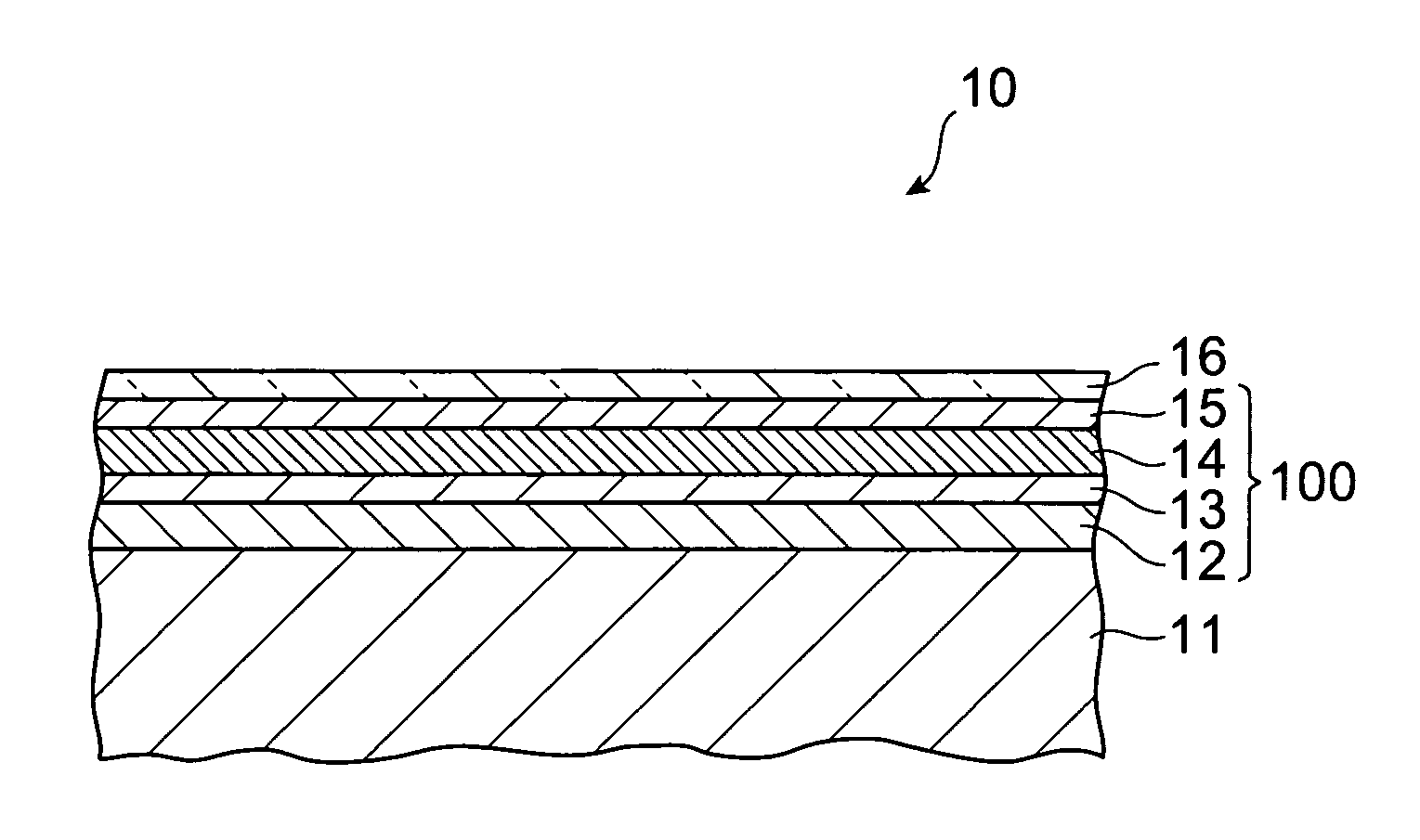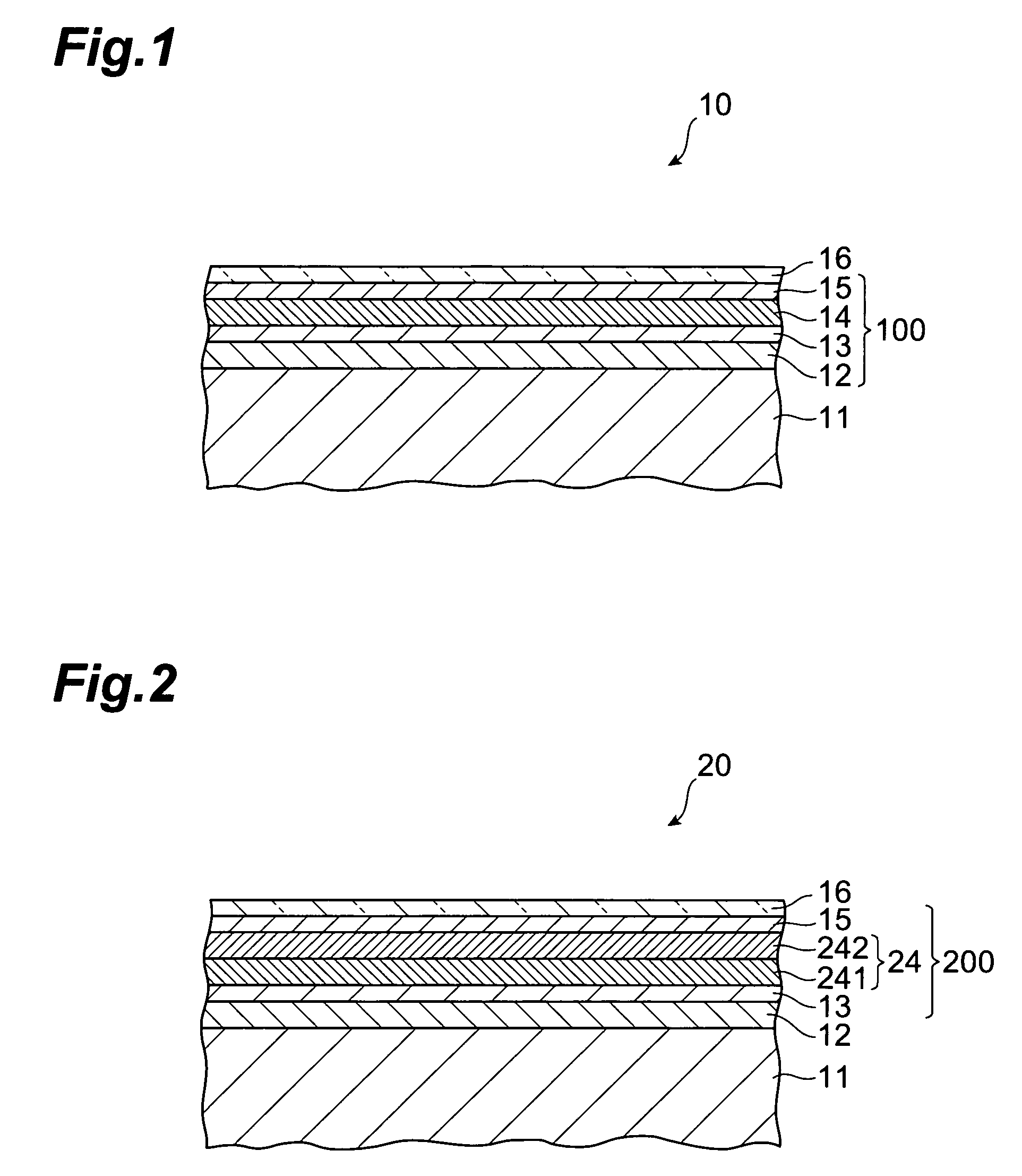Photoelectric transducer, photoelectric transducer apparatus, and iron silicide film
a technology of photoelectric transducer and iron silicide film, which is applied in the direction of electrical apparatus, photovoltaics, semiconductor devices, etc., can solve the problems of affecting the degeneration and characteristics of layers (films) and device characteristics, increasing the heat fed into the substrate to be formed with the device, and changing shape, etc., to achieve excellent semiconductor characteristics, easy manufacturing, and high conversion efficiency
- Summary
- Abstract
- Description
- Claims
- Application Information
AI Technical Summary
Benefits of technology
Problems solved by technology
Method used
Image
Examples
first embodiment
[0035]FIG. 1 is a schematic view showing a cross-sectional structure of the solar battery in accordance with a first embodiment. This solar battery 10 (photoelectric transducer) is one in which a metal electrode layer 12, a pin junction 100 (first pin junction part or photoelectric transducer), and a transparent electrode layer 16 are successively laminated on a substrate 11. Usable as the substrate 11 are silicon substrates, films made of polyamide resin or polyimide resin, etc.
[0036]Though not restricted in particular, the metal electrode layer 12 is preferably constituted by a material which exhibits a predetermined high conductivity and is hard to be damaged by a high-temperature atmosphere of about 400° C., while its reactivity with individual layers (which will be explained later) constituting the pin junction 100 is as low as possible. Preferred examples of such a material include rare metals such as Au, Pt, Pd, Ir, and Ag; rare metal alloys such as Au—Pd, Au—Pt, Ag—Pd, and A...
second embodiment
[0049]FIG. 2 is a schematic view showing a cross-sectional structure of the solar battery in accordance with a second embodiment. This solar battery 20 (photoelectric transducer) has the same configuration as with the solar battery 10 shown in FIG. 1 except that it is equipped with a pin junction 200 (first pin junction part) in place of the pin junction 100. The pin junction 200 has the same configuration as with the pin junction 100 of the solar battery 10 except that it includes a composite i-layer 24 instead of the i-layer 14.
[0050]The composite i-layer 24 is constituted by an i-layer 241 (first i-layer or iron silicide film) made of amorphous FexSiy:H formed on the p-layer 13, and an i-layer 242 (second i-layer) made of amorphous silicon laminated on the first i-layer. Namely, the solar battery 20 is a hybrid photoelectric transducer apparatus in which a plurality of different kinds of i-layers are laminated. The i-layer 241 has the same structure as that of the i-layer 14 ment...
third embodiment
[0052]FIG. 3 is a schematic view showing a cross-sectional structure of the solar battery in accordance with a third embodiment. This solar battery 30 (photoelectric transducer apparatus) has the same configuration as with the solar battery 10 shown in FIG. 1 except that it further comprises a pin junction 300 (second pin junction part) between the pin junction 100 and the transparent electrode layer 16. The pin junction 300 comprises an n-layer 33 (second n-layer) formed like the n-layer 13, a p-layer 35 (second p-layer) formed like the p-layer 15, and an i-layer 34 (third i-layer) formed therebetween from amorphous silicon as with the i-layer 242.
[0053]Thus configured solar battery 30 is a tandem photoelectric transducer apparatus in which the pin junctions 100, 300 are arranged in series. Of photons incident on the i-layer 34 of the pin junction 300 by way of the transparent electrode layer 16, those having relatively short wavelengths are photoelectrically converted with a high ...
PUM
| Property | Measurement | Unit |
|---|---|---|
| temperature | aaaaa | aaaaa |
| thickness | aaaaa | aaaaa |
| thickness | aaaaa | aaaaa |
Abstract
Description
Claims
Application Information
 Login to View More
Login to View More - R&D
- Intellectual Property
- Life Sciences
- Materials
- Tech Scout
- Unparalleled Data Quality
- Higher Quality Content
- 60% Fewer Hallucinations
Browse by: Latest US Patents, China's latest patents, Technical Efficacy Thesaurus, Application Domain, Technology Topic, Popular Technical Reports.
© 2025 PatSnap. All rights reserved.Legal|Privacy policy|Modern Slavery Act Transparency Statement|Sitemap|About US| Contact US: help@patsnap.com



